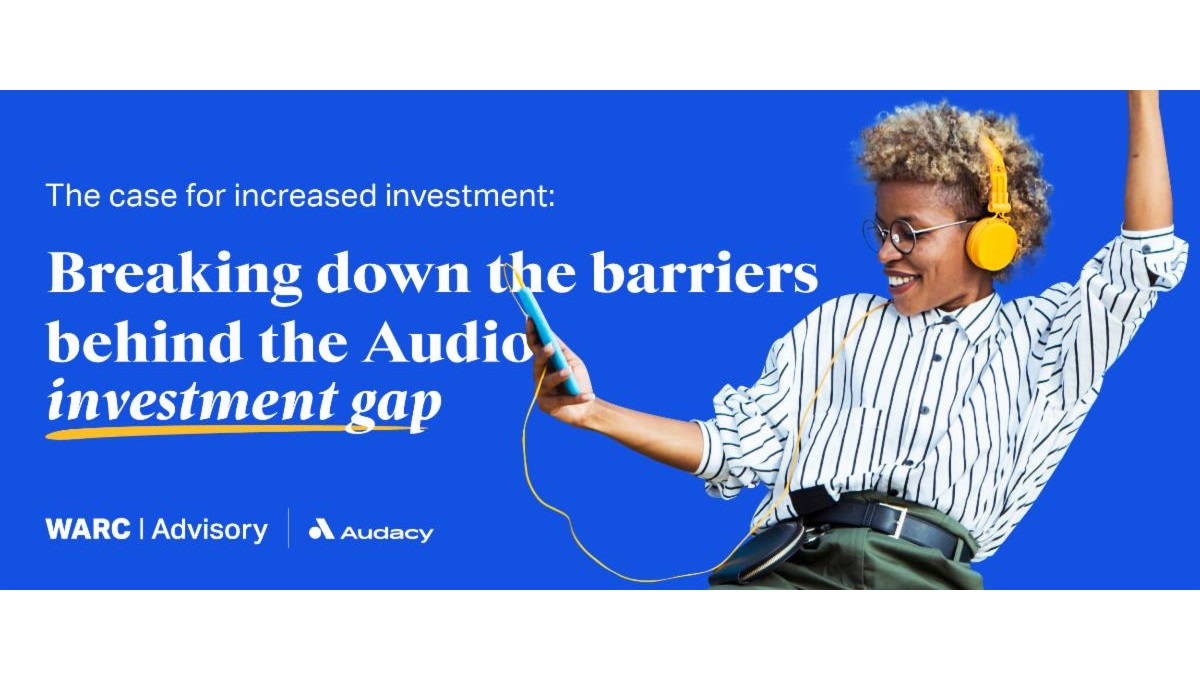A new white paper by WARC Advisory and Audacy explores the perceptual barriers driving the gap between audio advertising spend and audio consumption in the U.S.
In-depth interviews were conducted with more than 20 experts across leading brands, agencies, measurement companies and publishers. This white paper challenges long-held assumptions and demonstrates audio’s ability to drive multi-platform, full-funnel impact for advertisers
London / New York, December 3rd 2024 – A new white paper is released by WARC Advisory and multiplatform audio media and entertainment company Audacy today. Breaking down the barriers behind the Audio investment gap takes on a number of misperceptions driving the under-utilization of audio by marketers. In-depth interviews were conducted with 21 experts across leading brands, agencies, measurement companies and publishers in the audio field to better understand the issues from a 360 degree perspective.
Ray Borelli, SVP, Research & Insights, Audacy, comments, “There are more options available to marketers in audio than ever before, and we see time and again the positive results that come when brands increase their audio spend. However, investment in audio is being constrained for some by a series of perceptual barriers. This white paper aims to dispel those misperceptions and highlight the opportunities that are in front of marketers who embrace audio advertising.”
Paul Stringer, Managing Editor, Research & Advisory, WARC, adds: “Now – thanks to an explosion in audio listenership – there is a growing volume of evidence to suggest that audio drives a big impact in terms of attention, brand lift and key business KPIs. Yet a gap remains between investment and consumption. We’ve touched on this gap before in previous WARC research. But this paper goes one step further to understand precisely why audio is lagging behind other channels in terms of investment. After reading this paper, I hope advertisers and agencies feel more inspired and more confident about giving audio the attention and investment it deserves.”
“Breaking Down the Barriers Behind the Audio Investment Gap” spotlights the central role Audio plays in the lives of many Americans. Driven by growth in streaming and podcasts, time spent with Audio is growing significantly faster than media consumption overall.
Edison Research shows that average daily Audio consumption is 220 minutes: one-third of the total. This increase is evident across all age groups. Audiences aged 55 – 64 now spend 39% more time with Audio than they did in 2020; for those aged 16 – 24 the daily consumption has risen by 21%.
The medium’s challenge, however, is that it is realizing just 8.4% of advertiser spend, per WARC Media data. The findings show that spending would need to increase nearly threefold to match its share of ad-supported consumption.
This latest research uncovers myths that may lead to lack of investment in Audio.
Audio delivers high levels of reach, attention, targetability and full-funnel impact
Despite the misconception that Audio does not deliver campaign KPIs and is highly fragmented, evidence shows the medium delivers attributes that brands need most:
Unparalleled reach: In the USA, Audio’s total daily reach is 96%. Broadcast radio alone reaches 84% and 34% of Americans listen to at least one podcast a week.
High levels of attention: Podcast ads register 10,630 attentive seconds per thousand impressions (APMs) compared to TV at 4,430 APMs.
Strong targetability: Audio buys are now based on consumer interests, behaviors and contextually relevant moments.
Positive impact across every stage of the path-to-purchase journey: Recent research by Radiocentre found that allocating budget to the channel enhances overall campaign performance by boosting organic search volumes, increasing paid search impressions with improved conversion and uplifting response to paid social ads. Nielsen states that Audio consistently ranks as a top-tier medium for ROI.
Audio leverages comms opportunities through trust, engagement, culture and community
Given its unique characteristics, Audio is felt to be particularly difficult to integrate into the mix. This is exacerbated by a widespread belief that visual assets are essential to effective communication, but evidence shows that the channel is highly trusted.
Including radio in a campaign significantly increases brand trust according to System1 and Radiocentre in the UK; it enables brands to penetrate local communities and cultures – sports radio listeners are 3x more likely to search for a sponsor’s brand and 4x more likely to purchase its product or service than non-listeners; it is a media multiplier when working alongside other platforms; and creates new opportunities for integration – through display banners and videos and ‘podfluencers.’
Advances in Audio measurement & optimization
In an increasingly data-driven market, there are concerns about measuring Audio’s effectiveness. However, Audio measurement is evolving and effective tools now exist to track conversion, enabling brands to optimize campaigns mid-flight.
By combining pixel-tracking with systems from companies like Claritas, Veritone and ArtsAI, brands can now match audio ad exposure to online and in-store conversion. Additionally, brands are able to evaluate share of search, but care needs to be taken with attribution and marketing mix models (MMM); unless properly calibrated, they often fail to pick up Audio’s full impact.


